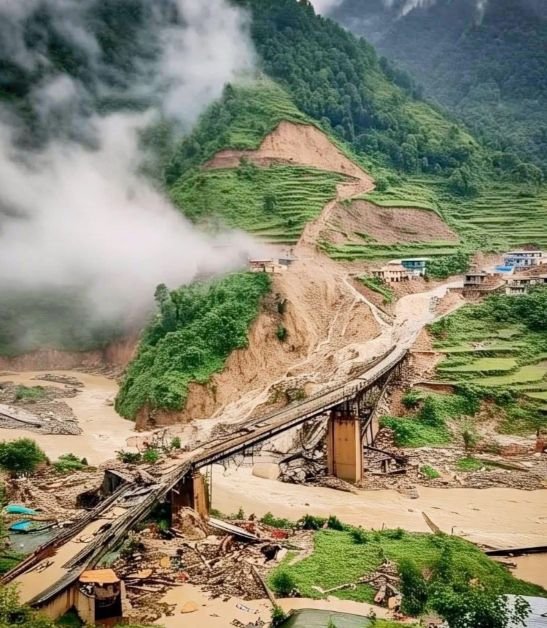Himachal Pradesh, once revered for its pristine valleys and serene mountain landscapes, is today caught in the throes of a catastrophic monsoon spell. The lush green hills have turned into a landscape of sorrow, echoing with cries for help, crumbling roads, flooded villages, and collapsing homes. Over the past ten days, this peaceful Himalayan state has been cursed with a relentless series of cloudbursts, landslides, flash floods, and extreme weather events that have not only destroyed infrastructure but shattered lives and livelihoods.
As per the Himachal Pradesh State Disaster Management Authority, a staggering 44 people have lost their lives in just ten days, with 18 others still missing. Over 250 roads lie crippled, more than 600 power transformers are out of service, and upwards of 100 water supply schemes have been disrupted. Entire districts like Mandi, Kullu, Solan, and Kangra are reeling under this devastation, yet the state administration appears paralysed, unable to mount a response proportionate to the scale of the disaster.
In the Mandi district alone, the situation has turned apocalyptic. Overnight cloudbursts in the Karsoog and Gohar regions swept away homes, vehicles, and families. One village lost nine members from the same family in a flash flood. The Pandoh Dam, which regulates the volatile Beas River, has reached dangerously close to its warning mark of 2941 feet, prompting authorities to release over 1.5 lakh cusecs of water into the river, swelling it into a raging torrent. The river, once a symbol of lifeblood for the region, has now become a threat, flooding towns like Mandi city and reaching the steps of Panchvaktra temple.
Everywhere one looks, the land tells a tale of ruin. The Chandigarh-Manali highway—a lifeline for tourism and trade—is blocked at multiple points due to massive landslides and sunken roads. Villages have been cut off from the rest of the state. With electricity poles snapped and roads obliterated, entire communities are living without power, water, or communication for days on end. In these moments of desperation, many have had to spend nights trapped in vehicles or makeshift shelters, as access to relief remains limited.
The meteorological department has not offered any hope. With fresh red and orange alerts issued for districts like Mandi, Solan, Sirmaur, and Kangra, the next 24 to 48 hours remain crucial and potentially more dangerous. But as nature unleashes its wrath, the people feel abandoned. Despite repeated weather warnings, there has been little evidence of proactive evacuation or pre-emptive disaster planning. Relief and rescue operations are largely reactive, and the common sentiment is that the government is simply watching as people struggle to survive.
In Solan, 44 people were injured after an HRTC bus skidded and overturned on a rain-soaked highway. In Kullu, the NH-305 remains blocked due to landslides. In Karsha village, floodwaters from a swollen stream crushed a vehicle, while in remote hill settlements, families sit helpless, watching their crops wash away. This is not just a weather event—it’s a humanitarian crisis unfolding in slow motion.
The sorrow in the hills is deep. Parents are looking for their children, villages mourn their dead, and survivors are battling trauma as they clear debris with their bare hands. Children have been pulled from rubble, elders sit by the remains of their homes, and livestock—the backbone of many rural families—lies lifeless in the muck. The dreams of thousands have been drowned under murky floodwaters, while their government issues statements and tours damage sites like photo-op locations.
Chief Minister Sukhvinder Singh Sukhu has instructed district collectors to close schools and monitor rivers, but the public demands more than advisories. They need action, aid, and accountability. Many are asking: where is the promised disaster-resilient infrastructure? Where are the rapid response teams before the damage is done? How many more lives need to be lost before the monsoon disaster is treated like the emergency it is?
Himachal Pradesh is not just facing rainfall—it is facing a crisis of governance in the face of an environmental breakdown. And as climate change makes extreme weather more frequent and unpredictable, the state must shift from reaction to preparation. The lives lost cannot be brought back, but perhaps they can be honoured by building a system that protects the living.
Until then, the cries from the hills echo unanswered.
#HimachalFloods #CloudburstDisaster #MonsoonWrath #MandiLandslide #ClimateEmergency
This is an auto web-generated news web story.
